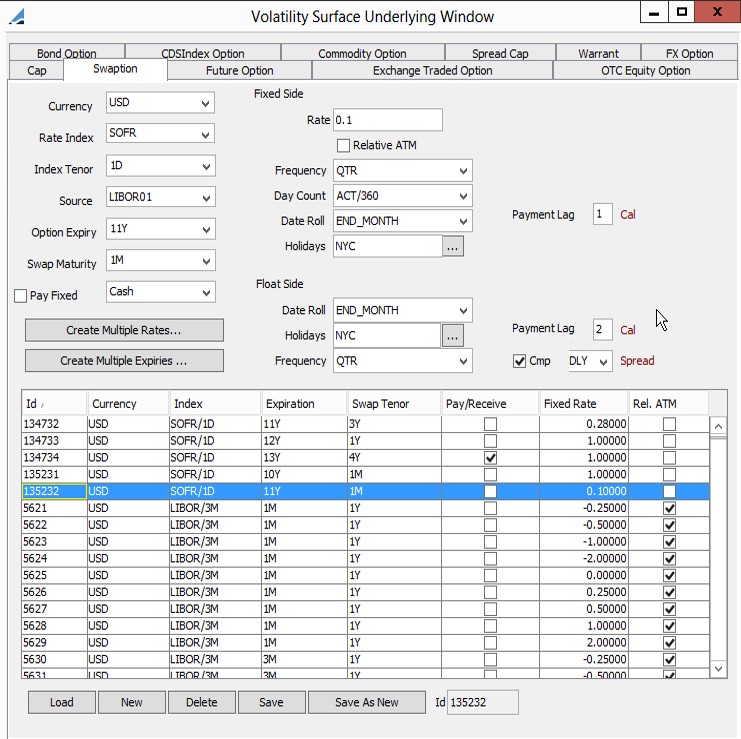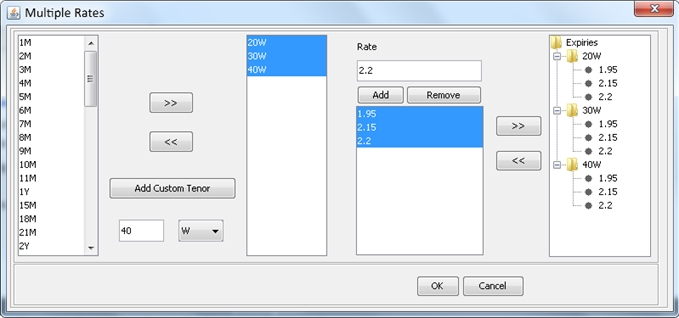Swaption - Vol Surface Underlying
The Swaption underlying can be used in construction of the RATE volatility surfaces.
Swaption Configuration
| • | Create the Rate Index Definition in Configuration > Interest Rates > Rate Index Definitions from the Calypso Navigator. |
1. Swaption Volatility Surface Underlying
Create the underlying instruments in the Volatility Surface Underlying Window, Swaption panel.

| » | Click New to create new volatility surface underlying. |
Complete the details as described in the table below.
| » | Click Save to create the underlying. They appear in the table below. |
The system creates quotes like in the following example.

Fields Details
| Field | Description | ||||||||||||||||||
|---|---|---|---|---|---|---|---|---|---|---|---|---|---|---|---|---|---|---|---|
|
Currency |
Base currency selected in the Currency drop-down list in the bottom of the window. | ||||||||||||||||||
|
Rate Index |
Select the rate index. | ||||||||||||||||||
|
Index Tenor |
Tenor for the index. | ||||||||||||||||||
|
Source |
Quoting source for the index. | ||||||||||||||||||
|
Option Expiry |
Tenor for the option expiry. | ||||||||||||||||||
|
Swap Maturity |
Maturity for the swap. | ||||||||||||||||||
|
Pay Fixed |
Select the cash settlement method in order to affect the calculation of the value of the underlying when generating the surface. | ||||||||||||||||||
|
Create Multiple Rates |
You can click Create Multiple Rates to create multiple rates for instruments in the Multiple Rates window.
Ⓘ [NOTE: before creating multiple rates, make sure to specify other relevant information for the fixed and float side - such as currency, rate index, source, date roll, and holidays - on the Swaption panel.] |
||||||||||||||||||
| Create Multiple Expiries | You can click Create Multiple Expiries to create multiple instruments associated with the specified expiries. | ||||||||||||||||||
| Payment Lag | Enter the number of days between the interest date and the payment date, and specify Business or Calendar. | ||||||||||||||||||
| Cmp |
Check the Cmp checkbox to enable interest compounding.
There is no compounding otherwise. |
||||||||||||||||||
|
Fixed Side |
|||||||||||||||||||
|
Rate |
Enter the fixed interest rate in percentage. | ||||||||||||||||||
|
Relative ATM |
Select for relative at-the-money. | ||||||||||||||||||
|
Frequency |
Payment frequency. | ||||||||||||||||||
|
Day Count |
Select the daycount convention used for determining the periods. | ||||||||||||||||||
|
Date Roll |
Select the date roll convention to use when the date falls on a non-business day. | ||||||||||||||||||
|
Holidays |
Holiday calendars used in calculating the pay dates. | ||||||||||||||||||
|
Float Side |
|||||||||||||||||||
|
Date Roll |
Select the date roll convention to use when the date falls on a non-business day. | ||||||||||||||||||
|
Holidays |
Holiday calendars used in calculating the pay dates. | ||||||||||||||||||
|
Frequency |
Payment frequency. | ||||||||||||||||||
|
Other Details |
|||||||||||||||||||
|
Id |
Displays the system assigned unique identifier for the Swaption volatility surface underlying. | ||||||||||||||||||
